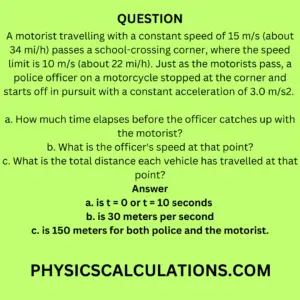Question
A motorist travelling with a constant speed of 15 m/s (about 34 mi/h) passes a school-crossing corner, where the speed limit is 10 m/s (about 22 mi/h). Just as the motorists pass, a police officer on a motorcycle stopped at the corner and starts off in pursuit with a constant acceleration of 3.0 m/s2.
a. How much time elapses before the officer catches up with the motorist?
b. What is the officer’s speed at that point?
c. What is the total distance each vehicle has travelled at that point?

Answer
The final answer for:
a. is t = 0 or t = 10 seconds
b. is 30 meters per second
c. is 150 meters for both police and the motorist.
Explanation
Data: Information from the question
The police officer’s position, xp = ?
Motorist position, xm = ?
Origin at the corner, x0 = 0
Initial velocity of the police, up = 0
The initial velocity of the motorist, um = 15 m/s
Constant acceleration of the police, ap = 3 m/s2
Acceleration of the motorist, am = 0
a.
Formula: The equations that will help us solve the problem for a
For the motorist, xm = x0 + umt + (1/2)amt2
While for the police officer, xp = x0 + upt + (1/2)apt2
Solution
using x0 = 0, am = 0, and up = 0 and equating both equations for the motorist and the police officer, we will get:
umt = (1/2)apt2
Therefore, we have:
t = 0 or t = 2(um/ap) = 2 (15/3) = 10 seconds
Therefore, the motorist passes the parked motorcycle at the corner at a time t = 0. Additionally, the police officer catches up with the motorist at the time t = 10 seconds.
b.
Formula: The equations that will help us solve the problem for b
By using vp = up + apt
and up = 0, while ap = 3 m/s2
Thus, by substituting our equation with our data, we will obtain
vp = up + apt = 0 + 3t
vp = 3t
At t = 10 s, the above equation will become vp = 3 x 10 = 30 m/s
Therefore, vp = 30 m/s shows that when the police officer overtakes the motorist, she is now using a speed of as twice as the motorist is.
c.
To find the distance the motorist cover in 10 seconds, we will say
xm = umt = 15 x 10 = 150 m
While the distance for the police officer is
xp = (1/2)apt2 = (1/2) x 3 x 102 = 150 m
Therefore, the police officer catches up with the motorist when they cover equal distances.
You may also like to read: